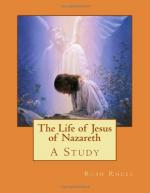The Journey through Perea to Jerusalem
63. Read SandayHastBD II. 630-632; see GilbertLJ 298-310: WeissLX III. 157-223; KeimJN V, 1-64; BeysLJ I. 287-294. II. 333-419; AndLOL 365-420; EdersLJM II. 126-360.
64. This journey began sometime between Tabernacles and Dedication (October and December) of the last year of Jesus’ life, and continued until the arrival in Bethany six days before the last Passover.
65. Geographical notes. Perea—a part of the domain of Antipas—was the Jewish territory E of the Jordan. Its northern limit seems to have been marked by Pella (Jos. Wars, iii 3. 3) or Gadara (Wars, iv. 7. 3), and its E boundary was marked by Philadelphia (Ant. xx. 1. 1); it extended S to the domain of Aretas, king of Arabia. The population was mixed, though predominatingly Jewish. Cities of the Decapolis, however, lay within the limits of Perea, and introduced Greek life and ideas to the people. On the highlands back from the Jordan it was a fertile and well populated land. See SmithHGHL 539f.; SchuererJPTX II. i. 2-4.
66. On Bethany and Jericho see BDs and, for the latter, SmithHGHL 266 ff.
67. Ephraim, (John xi. 54) is generally identified with the Ephron of II. Chron. xiii. 19 (Jos. Wars, iv. 9. 9). Robinson located it at et Taiyibeh, 4 m. NE of Bethel, and 14 from Jerusalem. See HastBD l. 728; SBD^2 975.
68. General questions. The mission of the seventy. Luke records two missions, that of the twelve (ix. 1-6), and that of the seventy (x. 1-24). Many regard these as doublets, similar to the two feedings in Mark. So WeissLX II. 307 ff., BeysLJ I. 275, WendtLJ I. 84f. In favor of this conclusion emphasis is given to the fact that in Jewish thought seventy symbolized the nations of the world as twelve symbolized Israel. It is suggested that in his search for full records Luke came upon an account of the mission of disciples which had already been modified in the interests of Gentile Christianity, and failing to recognize its identity with the account of the mission furnished by Mark, he added it in his peculiar section. The similarity of the instructions given follows from the nature of the case. A second sending out of disciples is suitable in view of the entrance into a region hitherto unvisited. As Dr. Sanday has remarked, the sayings connected by Luke with this mission bear witness to the authenticity of the account. There is therefore no need to identify the two missions. See particularly SandayHastBD II. 614, also GilbertLJ 226-230, Plummer’s Comm. on Luke, 269 ff. Luke probably gives the correct place for the thanksgiving, self-declaration, and invitation of Jesus, in which the synoptists approach most nearly to the thought of John (Lk. x. 21, 22; Mt. xi. 25-30). The return of the seventy (Lk. x. 17-20) followed the woes addressed to the unbelieving cities (Lk. x. 13-16; Mt. xi. 20-24).




